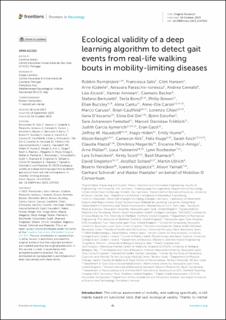| dc.contributor.author | Romijnders, Robbin | |
| dc.contributor.author | Salis, Francesca | |
| dc.contributor.author | Hansen, Clint | |
| dc.contributor.author | Küderle, Arne | |
| dc.contributor.author | Paraschiv-Ionescu, Anisoara | |
| dc.contributor.author | Cereatti, Andrea | |
| dc.contributor.author | Alcock, Lisa | |
| dc.contributor.author | Aminian, Kamiar | |
| dc.contributor.author | Becker, Clemens | |
| dc.contributor.author | Bertuletti, Stefano | |
| dc.contributor.author | Bonci, Tecla | |
| dc.contributor.author | Brown, Philip | |
| dc.contributor.author | Buckley, Ellen | |
| dc.contributor.author | Cantu, Alma | |
| dc.contributor.author | Carsin, Anne-Elie | |
| dc.contributor.author | Caruso, Marco | |
| dc.contributor.author | Caulfield, Brian | |
| dc.contributor.author | Chiari, Lorenzo | |
| dc.contributor.author | D'Ascanio, Ilaria | |
| dc.contributor.author | Del Din, Silvia | |
| dc.contributor.author | Eskofier, Björn | |
| dc.contributor.author | Fernstad, Sara Johansson | |
| dc.contributor.author | Fröhlich, Marceli Stanislaw | |
| dc.contributor.author | Garcia Aymerich, Judith | |
| dc.contributor.author | Gazit, Eran | |
| dc.contributor.author | Hausdorff, Jeffrey M. | |
| dc.contributor.author | Hiden, Hugo | |
| dc.contributor.author | Hume, Emily | |
| dc.contributor.author | Keogh, Alison | |
| dc.contributor.author | Kirk, Cameron | |
| dc.contributor.author | Kluge, Felix | |
| dc.contributor.author | Koch, Sarah | |
| dc.contributor.author | Mazzà, Claudia | |
| dc.contributor.author | Megaritis, Dimitrios | |
| dc.contributor.author | Micó-Amigo, Encarna | |
| dc.contributor.author | Müller, Arne | |
| dc.contributor.author | Palmerini, Luca | |
| dc.contributor.author | Rochester, Lynn | |
| dc.contributor.author | Schwickert, Lars | |
| dc.contributor.author | Scott, Kirsty | |
| dc.contributor.author | Sharrack, Basil | |
| dc.contributor.author | Singleton, David | |
| dc.contributor.author | Soltani, Abolfazl | |
| dc.contributor.author | Ullrich, Martin | |
| dc.contributor.author | Vereijken, Beatrix | |
| dc.contributor.author | Vogiatzis, Ioannis | |
| dc.contributor.author | Yarnall, Alison | |
| dc.contributor.author | Schmidt, Gerhard | |
| dc.contributor.author | Maetzler, Walter | |
| dc.date.accessioned | 2024-01-25T14:28:33Z | |
| dc.date.available | 2024-01-25T14:28:33Z | |
| dc.date.created | 2023-11-23T10:41:12Z | |
| dc.date.issued | 2023 | |
| dc.identifier.citation | Frontiers in Neurology. 2023, 14 . | en_US |
| dc.identifier.issn | 1664-2295 | |
| dc.identifier.uri | https://hdl.handle.net/11250/3113916 | |
| dc.description.abstract | Introduction: The clinical assessment of mobility, and walking specifically, is still mainly based on functional tests that lack ecological validity. Thanks to inertial measurement units (IMUs), gait analysis is shifting to unsupervised monitoring in naturalistic and unconstrained settings. However, the extraction of clinically relevant gait parameters from IMU data often depends on heuristics-based algorithms that rely on empirically determined thresholds. These were mainly validated on small cohorts in supervised settings.
Methods: Here, a deep learning (DL) algorithm was developed and validated for gait event detection in a heterogeneous population of different mobility-limiting disease cohorts and a cohort of healthy adults. Participants wore pressure insoles and IMUs on both feet for 2.5 h in their habitual environment. The raw accelerometer and gyroscope data from both feet were used as input to a deep convolutional neural network, while reference timings for gait events were based on the combined IMU and pressure insoles data.
Results and discussion: The results showed a high-detection performance for initial contacts (ICs) (recall: 98%, precision: 96%) and final contacts (FCs) (recall: 99%, precision: 94%) and a maximum median time error of −0.02 s for ICs and 0.03 s for FCs. Subsequently derived temporal gait parameters were in good agreement with a pressure insoles-based reference with a maximum mean difference of 0.07, −0.07, and <0.01 s for stance, swing, and stride time, respectively. Thus, the DL algorithm is considered successful in detecting gait events in ecologically valid environments across different mobility-limiting diseases. | en_US |
| dc.language.iso | eng | en_US |
| dc.publisher | Frontiers Media | en_US |
| dc.rights | Navngivelse 4.0 Internasjonal | * |
| dc.rights.uri | http://creativecommons.org/licenses/by/4.0/deed.no | * |
| dc.title | Ecological validity of a deep learning algorithm to detect gait events from real-life walking bouts in mobility-limiting diseases | en_US |
| dc.title.alternative | Ecological validity of a deep learning algorithm to detect gait events from real-life walking bouts in mobility-limiting diseases | en_US |
| dc.type | Peer reviewed | en_US |
| dc.type | Journal article | en_US |
| dc.description.version | publishedVersion | en_US |
| dc.source.pagenumber | 0 | en_US |
| dc.source.volume | 14 | en_US |
| dc.source.journal | Frontiers in Neurology | en_US |
| dc.identifier.doi | 10.3389/fneur.2023.1247532 | |
| dc.identifier.cristin | 2200806 | |
| cristin.ispublished | true | |
| cristin.fulltext | original | |
| cristin.qualitycode | 1 | |

